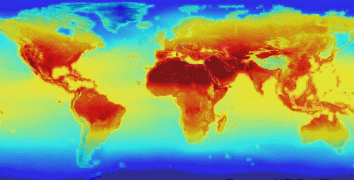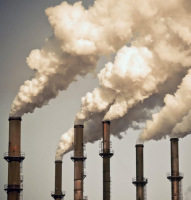 The term 'climate change' refers to long-term shifts in temperatures and world-wide weather patterns. Since the 1800s, human activities have been the main driver of climate change, primarily due to the burning of fossil fuels like coal, oil and gas.  This phenomenon used to be called 'global warming', but many people misunderstood the process, thinking that all loctions on Earth must be getting warmer. In fact, only the average overall temperature of the Earth is increasing; some regions are getting hotter, while others are experiencing colder temperatures as Earth's climate warms, and individual locations experience often unpredictable weather changes.
This phenomenon used to be called 'global warming', but many people misunderstood the process, thinking that all loctions on Earth must be getting warmer. In fact, only the average overall temperature of the Earth is increasing; some regions are getting hotter, while others are experiencing colder temperatures as Earth's climate warms, and individual locations experience often unpredictable weather changes.
 Burning fossil fuels generates greenhouse gas emissions, mainly carbon dioxide and methane. Massive amounts of these gases, and others, are emitted from vehicles powered by fossil fuel burning engines. Clearing land and cutting down forests also releases carbon dioxide. Agriculture, oil and gas operations are major sources of methane emissions.
Burning fossil fuels generates greenhouse gas emissions, mainly carbon dioxide and methane. Massive amounts of these gases, and others, are emitted from vehicles powered by fossil fuel burning engines. Clearing land and cutting down forests also releases carbon dioxide. Agriculture, oil and gas operations are major sources of methane emissions. Dramatic increases in these gases in the atmosphere act like a blanket wrapped around the Earth, trapping the Sunís heat and raising Earth's average temperature. The consequences of climate change now include, among others, intense droughts, water scarcity, severe and more requent fires, rising sea levels, flooding, melting polar ice, catastrophic storms, and declining biodiversity. The effects of human-caused global warming are happening now, are irreversible for people alive today, and will worsen as long as humans continue to add add greenhouse gases to the atmosphere.  Dealing with the problems caused by a changing climate must be realistic. Agriculture and industry rely on fossil fuels to operate, and this is not likely to change soon. The automotive industry, however, is attempting to reduce the number of pollutant-emitting fossil fuel burning vehicles on the road by introducing electric vehicles. Regardless of what steps are taken, the future will hold many changes for our children and grandchildren. |